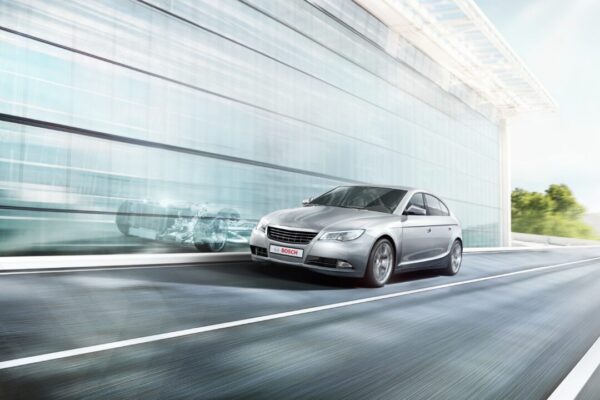
Bosch adjusts course for future mobility requirements
The new concept of the Swabian giant (worldwide more than 200.000 employees, 128 manufacturing sites and 59 R&D labs for the automotive activities alone) aims at future-proof interconnected traffic systems – systems that enable users to remain mobile even under even under the conditions of global urbanisation, environmental restrictions an ageing population.
To visualise the shift of emphasis, Bosch re-baptised its automotive technology branch to “Mobility Solutions”, which transports a more neutral and application-oriented approach. In his keynote speech Mobility Solutions CEO Rolf Bulander illustrated the company’s intentions. “We have to look beyond the engine bonnet”, he said. “We already supply more than brake and fuel injection systems. We provide systems for the entire scope of mobility which includes systems that enable and secure the interplay of cars with other modes of transport and with the infrastructure”.
According to Bulander, the reality of future mobility will manifest itself somewhere between two extreme scenarios: Scenario one, dubbed “Fun for Everyone” is characterised by the continuation of the current model with some additional ingredients such as internet connectivity. Scenario two, called “Ecologial Globalisation” calls for a world full of megacities that see the need to restrict individual mobility for environmental reasons. To enable individual mobility as far as possible, Bulander believes that connectivity, automated driving and electrification will play a pivotal role. Plus, these elements are compatible with both future scenarios – with fun and ecology, the manager advertised.
In this context, Bulander unfolded Bosch’s roadmap in front of the journalists. Key points are:
- By 2020, the cost level for traction batteries will fall by 50 %. The company is firmly focused on lithium-ion technology; Bulander ruled out alternative materials. According to Bosch, fuel cells face inadequate infrastructure and high cost.
- In the same time frame, the company expects that the number of charging stations worldwide will grow by the factor of ten compared to the level of 2013. Thus, Bosch expects that in 2020 a million charging stations will be up and running worldwide, laying the foundation for significant growth for the electromobility sector.
- By 2025, 15 percent of all new vehicles will have some kind of electric drive, which includes HEVs and PHEVs
- Nevertheless, the internal combustion engine will continue to be the most popular means of propulsion; Bosch believes that within five years, the fuel efficiency of diesel engines can be improved by another 10 percent, of gasoline engines by 20 percent.
On the road to autonomous driving, various types of driver assistance systems with increasing complexity will offload the drivers and gradually introduce semi-autonomous and autonomous forms of driving. Already during the current year, Bosch plans to bring several new assistant systems to series maturity. Examples are systems for automated valet parking, traffic stall assistant, emergency steer assistant and left turn assistant (for countries with left-hand traffic: right turn assistant).
MEMS sensors determine free parking space
The vehicles’ capability to communicate is expected to go soon beyond functionalities like predictive maintenance and fleet management. According to Bulander, Bosch is developing systems that help car drivers to find free spaces faster. This is relevant because in large cities, drivers searching for a free parking space account for up to 30 percent of the whole traffic. Bosch’s contribution: Parking lots and car parks could be equipped with networked MEMS sensors that can signal vacant spaces to databases which in turn guide the drivers to the next available space in real-time. In addition to the sensors, Bosch will develop the networking technology for such systems. Likewise, the company predicts networked and interlocked multi-modal traffic systems that support bike sharing, trams, buses and other means of traffic with cross-modal rental and payment systems. “We expect that networking functions will be a very significant driver for the development”, Bulander said.

Figure 1: Automated and electrical: Bosch showed a prototype autopilot system on a Tesla Model S.
He also provided details as to specific product groups. While the number of radar sensors produced exceeded the number of 50 million units in the past year, the company still does not offer lidar sensors though all major OEMs believe that this sensor type is essential to implement autonomous driving functions. This might change, Bosch is mulling the development of such sensors. Likewise, after the takeover of ZF’s shares in ZF Lenksysteme, the company is working on a rear-axle steering systems. “It remains open if such systems offer enough benefit for a series production”, Bulander said.
At the event, the company showed a large number of driver assistance system prototypes, including
- Vehicle height assist: The system determines the height of a passage (bridge, underground garage) by means of a stereo camera and issues a warning, if the passage is not high enough for the vehicles.
- Rear traffic alert: The system issues a warning and optionally brakes automatically backwards and cross-traffic is approaching
- Wrong driver warning: In some countries, drivers entering the wrong directional lane on highways often cause heavy accidents. Bosch’s wrong driver warning system is based on a smartphone app that utilises GPS data to determine if the driver is in the right lane and a corresponding app in the car. If necessary, it issues a cascaded warning concept with acoustic, optic and haptic signals. If necessary it performs an emergency stop and transmits a message to the traffic management system of the respective highway.
- Predictive power train: This system utilises the “electronic horizon” that connects the powertrain to the internet, taking into account gradients, sped limits and traffic congestions to optimise the energy consumption. Particularly relevant for battery-operated vehicles.
- An automatic driving system that enabled longitudinal and lateral control of the vehicle: Powertrain, brakes and steering were controlled by an array of sensors including radar, video and lidar. The system was implemented on a Tesla Model S.
Related articles:
Bosch seeks to hire thousands of engineers
Bosch bets on synergies between electromobility and connectivity
Bosch CEO predicts cheaper batteries, networked traffic
GM spurs development of automated driving
 If you enjoyed this article, you will like the following ones: don't miss them by subscribing to :
eeNews on Google News
If you enjoyed this article, you will like the following ones: don't miss them by subscribing to :
eeNews on Google News




